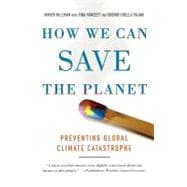
Note: Supplemental materials are not guaranteed with Rental or Used book purchases.
Purchase Benefits
Looking to rent a book? Rent How We Can Save the Planet Preventing Global Climate Catastrophe [ISBN: 9780312352066] for the semester, quarter, and short term or search our site for other textbooks by Hillman, Mayer; Fawcett, Tina; Rajan, Sudhir Chella. Renting a textbook can save you up to 90% from the cost of buying.
| Acknowledgments | p. ix |
| Introduction | p. 1 |
| The Problem | |
| Beyond the Planet's Limits: Climate Change: Why, How, and What Next? | p. 11 |
| As If There's No Tomorrow: Energy Use: Past, Present, and Future | p. 37 |
| Eyes Wide Shut: The Response of the General Public | p. 72 |
| Current Strategies | |
| Wishful Thinking: The Role of Technology | p. 89 |
| Fiddling While Rome Burns: What Government Is Doing to Reduce Fossil Fuel Dependence | p. 126 |
| Turning the Tanker Around: International Negotiations on Climate Change | p. 162 |
| The Solution | |
| The Blueprint for Survival: Contraction and Convergence | p. 177 |
| Fair Shares for All: Personal Carbon Allowances | p. 194 |
| Carbon Watchers: How to Live Within the Carbon Allowance | p. 213 |
| Conclusions: Climate by Negligence or Climate by Choice | p. 236 |
| Postscript | p. 245 |
| Appendix | p. 267 |
| References | p. 287 |
| Index | p. 305 |
| Biographies | p. 321 |
| Table of Contents provided by Ingram. All Rights Reserved. |
The New copy of this book will include any supplemental materials advertised. Please check the title of the book to determine if it should include any access cards, study guides, lab manuals, CDs, etc.
The Used, Rental and eBook copies of this book are not guaranteed to include any supplemental materials. Typically, only the book itself is included. This is true even if the title states it includes any access cards, study guides, lab manuals, CDs, etc.
Excerpted from How We Can Save the Planet: Preventing Global Climate Catastrophe by Mayer Hillman, Tina Fawcett
All rights reserved by the original copyright owners. Excerpts are provided for display purposes only and may not be reproduced, reprinted or distributed without the written permission of the publisher.